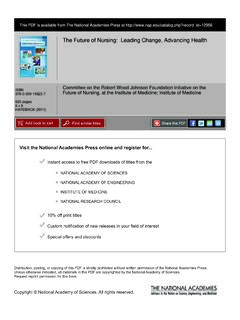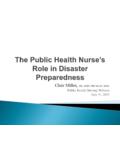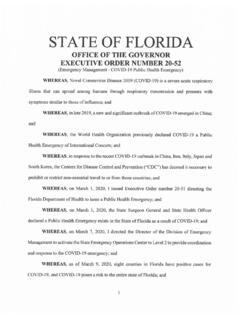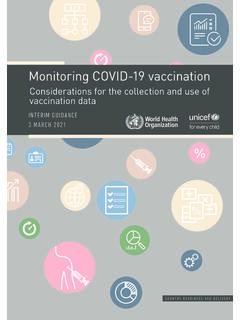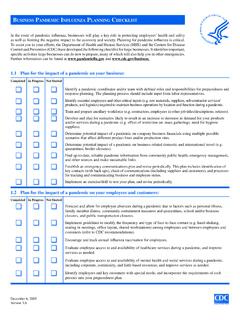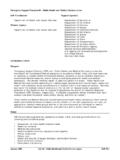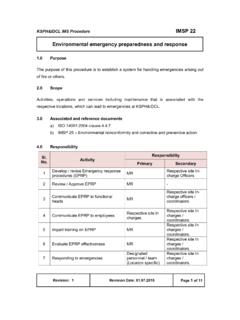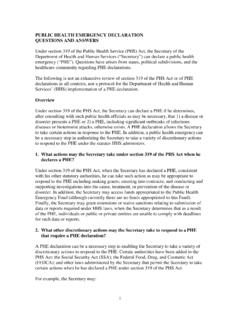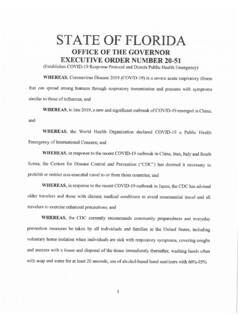Transcription of The Public Health Nurse’s Role in Disaster Preparedness
1 Clair Millet, MN, APRN, PHCNS-BC, DNPc Public Health Nursing Webinar July 31, 2013. Discuss the types of disasters, including natural and human made Identify what emergency Support Functions (ESFs) of the National response Framework apply to Public Health nursing during Disaster Describethe Public Health nursing role in Disaster Preparedness Images from: LA DHH. Disaster - dis as ter n. sudden calamitous event bringing great damage, loss, or destruction; broadly : a sudden or great misfortune or failure occurrence causing widespread disruption, destruction and distress requiring external assistance;. Image from Google Images A Disaster is present when need exceeds resources! A response NEED that is greater than the RESOURCES. that are available! Human-Made Events Warfare, Transportation accidents, Bombing, Structural collapse, Fires, Pollution, Hazardous Materials Incident (Oil Spill), Civil unrest, Terrorism (CBRNE incidents), Cyber attacks, Airplane crash, Water supply contamination Natural Disasters Earthquake, Volcano, Hurricane, Flood, Tornado, Landslide, Avalanche, Pandemics/Epidemics, Tsunamis, Extreme heat and cold, etc.
2 Images from LA DHH and retrieved from Google Images and Microsoft Office clip art 2002 Department of Homeland Security created 2003 Homeland Security Presidential Directive-8/Presidential Policy Directive (PPD)-8. (2011). National Preparedness 5 Preparedness Mission Areas: 1. Prevention 2. Protection 3. Mitigation 4. response 5. Recovery 2004 National response Plan (NRP). 2006 Pandemic & All Hazards Preparedness Act 2008 National response Framework (NRF evolved from NRP). National Incident Management System (NIMS) PPD 5 to include Incident Command System (ICS). emergency Support Functions (ESFs): 15 total ESF 8 : Public Health & Medical Two national documents to be aware of that guide Disaster Preparedness , response and recovery: Homeland Security Presidential Directive 21. Public Health & Medical Preparedness National Health Security Strategy Image retrieved from Google Images Public Health Nurses play a critical role in coordinating and implementing any Disaster response plan Largest segment of the Public Health workforce; Most trusted profession Community advocates Unique skill sets Must understand the Disaster cycle and be able to be integrated at every phase Images from: LA DHH.
3 Services provided should be consistent with the scope of practice; PHNs clinical knowledge regarding disease pathophysiology and epidemiology in conjunction with community assessment skills can serve a crucial role in emergency Preparedness and response Participation in healthcare policy development Images from: LA DHH. All-hazards mitigation Structural & Nonstructural Deter potential threats Take action to eliminate threats Hazard vulnerability assessment/risk assessment Increase security Increase testing specific to the event; increased surveillance Mass prophylaxis/immunization Assessment & identification of potential hazards/vulnerabilities Isolation & quarantine Halting of CBRNE threats Personal Professional Disaster competencies - International Council of Nurses (ICN) Framework of Disaster Nursing Competencies (ICN and World Health Organization, 2009). Public Health Preparedness and response Core Competencies (ASPH, 2010).
4 Community Training, Drills & Exercises Images from: LA DHH and Google Images National response Framework; NIMS; ICS. Event begins and ends at the local level Public Health nurses bring leadership, policy, planning and practice expertise to Disaster Preparedness & response First responders; triage Epidemiology; surveillance Rapid needs assessment Risk communication Assist with medical surge capacity Images from: LA DHH. Flexibility is important; attempt to return to usual operations. Community assessment Psychological support The Public Health nurse is the community and client advocate Images from: LA DHH. The Role of Public Health Nurses in Disaster Preparedness , response , and Recovery A Position Paper Association of Public Health Nurses (APHN). Public Health Preparedness Committee Goal for Completion: September 2013. APHN website Disaster Phase Definition Assessment Planning Implementation Evaluation Prevent a Disaster Assess a group of Develop community Conduct community Evaluate community or emergency ; elderly citizens for education plan to education activities education activities PREVENTION Minimize their awareness increase awareness to increase on preventing heat vulnerability to about preventing about preventing awareness about stroke.
5 (MITIGATION) effects of an event. heat stroke. heat stroke. preventing heat stroke. Assure capacity to Assess the Develop plans to Conduct training, Evaluate plans for respond effectively populations at risk care for special drills and exercises serving populations to disasters and for special needs needs populations related to care of with special needs. Preparedness emergencies. during a Disaster . during a Disaster . special-needs persons. Provide support to Serve on a response Develop plans to Deploy staff to Participate in after persons and team to determine rotate staff on shelters after a action reviews Communities the impact and response teams to hurricane, in and/or debriefings to affected by specific Health needs prevent stress and accordance with evaluate quality of response disasters and of hurricane burnout among local and/or state Health services emergencies. survivors. Triage responders.
6 emergency response provided and victims. plans. lessons learned. Restore systems Serve on team to Collaborate with Participate in Serve on team to to functional level. assess community partners and restoring community evaluate long-term assets and potential community leaders services after a impact on persons Recovery for recovery from a to plan long-term flood. displaced by a flood. recent flood. recovery priorities after a flood. Source: ASTDN 2007. National, Public Health , and Nursing References for understanding Public Health Nurse Practice in Disaster Preparedness , response , and Recovery American Nurses Association (ANA). 2008. Adapting standards of care under extreme conditions: Guidance for professionals during disasters, pandemics, and other extreme emergencies. Preparedness / Association for Community Health Nursing Educators (ACHNE) Task Force on Disaster Preparedness . 2008. Disaster Preparedness white paper for community/ Public Health nursing educators.
7 Association of Schools of Public Health (ASPH). 2010. Public Health Preparedness &. response core competency model. Centers for Disease Control and Prevention (CDC). 2012. Public Health Preparedness : 2012 state-by-state report on laboratory, emergency operations coordination, and emergency Public information and warning capabilities. CDC. 2011. A national strategic plan for Public Health Preparedness and response . CDC. March 2011. Public Health Preparedness capabilities: National standards for state and local planning. Federal emergency Management Agency (FEMA). 2013. Presidential Policy Directive (PPD). 8 components: National Preparedness goal, National Preparedness system, National planning frameworks. directive-8#NPF. FEMA emergency Management Institute (EMI). 2013. Independent study program (ISP). International Council of Nurses (ICN) and World Health Organization (WHO). 2009. ICN. framework of Disaster nursing competencies.
8 Institute of Medicine (IOM). 2012. Crisis standards of care: A systems framework for catastrophic Disaster response . National Commission on Children and Disasters. October 2010. 2010 Report to the president and congress, AHRQ Publication No. 10-M037. RESOLVE, Inc. 2012. Transforming Public Health : Emerging concepts for decision making in a changing Public Health world. research/2012/06 Trust for America's Health . December 2012. Ready or not: Protecting the Public from diseases, disasters, and bioterrorism. Department of Health and Human Services (DHHS). 2012. Implementation plan for the national Health security strategy of the United States of America. Clair Millet, MN, APRN, PHCNS-BC, DNPc Director of Nursing Louisiana Department of Health & Hospitals Office of Public Health (225) 342-7867. New England Alliance for Public Health Workforce Development Boston University School of Public Health Massachusetts Association of Public Health Nurses (MAPHN).
9 Please visit: Click on the "Evaluation Forms" link which will take you to the evaluation form in Survey Monkey Fill out your evaluation in Survey Monkey and at the end there will be instructions to click here to get your CE Certificate. Click to open up your certificate first and then submit your evaluation. Thank you! Questions please email: The link to the archives and the PP slides are available at To view the archive select the session you wish to view, click on the right facing arrow below the large black viewing box and the video will play. You can also access the archive link and the PP. slides on the MAPHN website at

